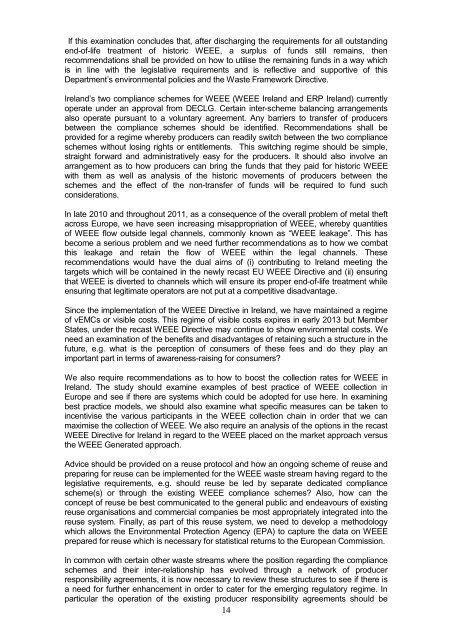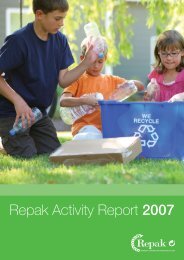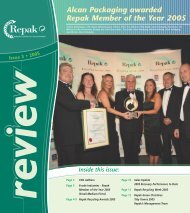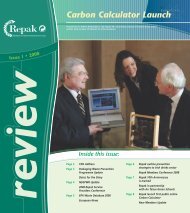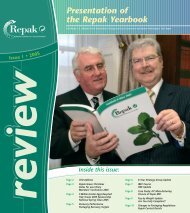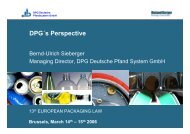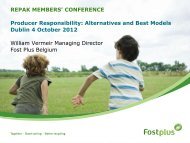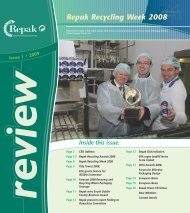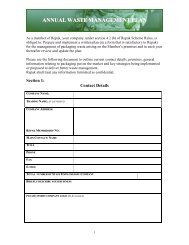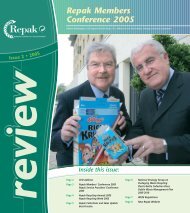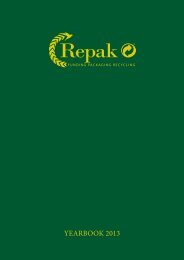Review Of The Producer Responsibility Initiative Model In ... - Repak
Review Of The Producer Responsibility Initiative Model In ... - Repak
Review Of The Producer Responsibility Initiative Model In ... - Repak
Create successful ePaper yourself
Turn your PDF publications into a flip-book with our unique Google optimized e-Paper software.
If this examination concludes that, after discharging the requirements for all outstanding<br />
end-of-life treatment of historic WEEE, a surplus of funds still remains, then<br />
recommendations shall be provided on how to utilise the remaining funds in a way which<br />
is in line with the legislative requirements and is reflective and supportive of this<br />
Department’s environmental policies and the Waste Framework Directive.<br />
Ireland’s two compliance schemes for WEEE (WEEE Ireland and ERP Ireland) currently<br />
operate under an approval from DECLG. Certain inter-scheme balancing arrangements<br />
also operate pursuant to a voluntary agreement. Any barriers to transfer of producers<br />
between the compliance schemes should be identified. Recommendations shall be<br />
provided for a regime whereby producers can readily switch between the two compliance<br />
schemes without losing rights or entitlements. This switching regime should be simple,<br />
straight forward and administratively easy for the producers. It should also involve an<br />
arrangement as to how producers can bring the funds that they paid for historic WEEE<br />
with them as well as analysis of the historic movements of producers between the<br />
schemes and the effect of the non-transfer of funds will be required to fund such<br />
considerations.<br />
<strong>In</strong> late 2010 and throughout 2011, as a consequence of the overall problem of metal theft<br />
across Europe, we have seen increasing misappropriation of WEEE, whereby quantities<br />
of WEEE flow outside legal channels, commonly known as “WEEE leakage”. This has<br />
become a serious problem and we need further recommendations as to how we combat<br />
this leakage and retain the flow of WEEE within the legal channels. <strong>The</strong>se<br />
recommendations would have the dual aims of (i) contributing to Ireland meeting the<br />
targets which will be contained in the newly recast EU WEEE Directive and (ii) ensuring<br />
that WEEE is diverted to channels which will ensure its proper end-of-life treatment while<br />
ensuring that legitimate operators are not put at a competitive disadvantage.<br />
Since the implementation of the WEEE Directive in Ireland, we have maintained a regime<br />
of vEMCs or visible costs. This regime of visible costs expires in early 2013 but Member<br />
States, under the recast WEEE Directive may continue to show environmental costs. We<br />
need an examination of the benefits and disadvantages of retaining such a structure in the<br />
future, e.g. what is the perception of consumers of these fees and do they play an<br />
important part in terms of awareness-raising for consumers<br />
We also require recommendations as to how to boost the collection rates for WEEE in<br />
Ireland. <strong>The</strong> study should examine examples of best practice of WEEE collection in<br />
Europe and see if there are systems which could be adopted for use here. <strong>In</strong> examining<br />
best practice models, we should also examine what specific measures can be taken to<br />
incentivise the various participants in the WEEE collection chain in order that we can<br />
maximise the collection of WEEE. We also require an analysis of the options in the recast<br />
WEEE Directive for Ireland in regard to the WEEE placed on the market approach versus<br />
the WEEE Generated approach.<br />
Advice should be provided on a reuse protocol and how an ongoing scheme of reuse and<br />
preparing for reuse can be implemented for the WEEE waste stream having regard to the<br />
legislative requirements, e.g. should reuse be led by separate dedicated compliance<br />
scheme(s) or through the existing WEEE compliance schemes Also, how can the<br />
concept of reuse be best communicated to the general public and endeavours of existing<br />
reuse organisations and commercial companies be most appropriately integrated into the<br />
reuse system. Finally, as part of this reuse system, we need to develop a methodology<br />
which allows the Environmental Protection Agency (EPA) to capture the data on WEEE<br />
prepared for reuse which is necessary for statistical returns to the European Commission.<br />
<strong>In</strong> common with certain other waste streams where the position regarding the compliance<br />
schemes and their inter-relationship has evolved through a network of producer<br />
responsibility agreements, it is now necessary to review these structures to see if there is<br />
a need for further enhancement in order to cater for the emerging regulatory regime. <strong>In</strong><br />
particular the operation of the existing producer responsibility agreements should be<br />
14


